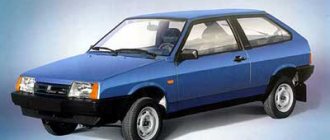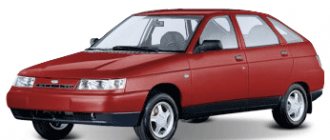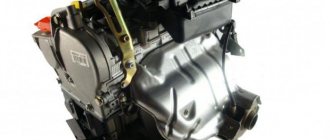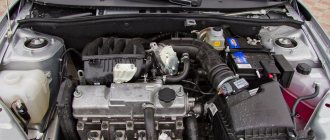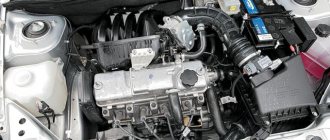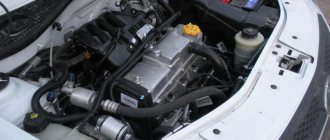VAZ 2109 (popularly called “nine”) is a Soviet front-wheel drive vehicle of group II small class in a hatchback body. The model was developed and mass-produced at the Volzhsky Automobile Plant from 1987-2004.
From 2004, cars (VAZ-21093) until the end of 2011 were assembled from vehicle kits at the Ukrainian enterprise ZAZ. This vehicle is also a five-door version of the VAZ-2108 in the Lada Sputnik model division. You can still buy this car on the used car market today. The entire Lada model range.
Car history
Towards the end of the 1980s, AVTOVAZ decided to fill the empty niche of comfortable and versatile family models with the VAZ-2109 car. The fact that the debut domestic mass-produced front-wheel drive car appeared at the Volga Automobile Plant was a significant event not only for the Volga residents, but also for the entire Soviet automobile industry.
It’s a little symbolic, but the start of production of the G8 coincided with a significant event that was celebrated in the fall of 1984 - the 60th anniversary of the automobile industry of the Union of Soviet Socialist Republics. After two years, the original assembly line of the car plant in Togliatti produced a pilot batch of 159 Nine models.
The new version of the “chisel” inherited all the technical innovations from the older model and was able to instantly gain the respect of car lovers. Among all the points, the most important was the “rational” number of doors. However, despite this, a three-door version entered mass production. The logical question arises, why?
Because in a state where personal transport was considered a luxury, and happy car owners felt the transport difficulties of their relatives and friends, the standard 3-volume sedan version was more suitable to the needs of drivers. For a long time, all Soviet mass-produced cars were produced in just such a body.
More productive station wagons, which were produced in small quantities, began to be sold only towards the end of the 1960s, and they were considered in great short supply. There was not a word about other versions of the body: directors of automobile enterprises did not even risk conducting experiments, objectively believing that these programs would not be positively received “at the top.”
But in the case of the G8, everything turned out in the opposite order. At the end of the 1970s, all of Europe was literally overwhelmed by the fashion for hatchbacks. The leaders of the Tolyatti automobile plant, wanting to comply with modern trends, during the design of the new model series, decided to introduce into it, in addition to the standard sedan, 3- and 5-door hatchbacks that were fundamentally fresh for Soviet industrial turnover.
The entry into the foreign market of a new car, designed in accordance with the standards of global trends, was supposed to strengthen VAZ's export positions. The Ministry of Automotive Industry cooled down the ardor of the engineers from Tolyatti a little, calculating the impossibility of financing the production of all 3 versions for assembly line assembly.
In reality, it was possible to free only one line of the factory conveyor for the assembly of 2 standardized modifications. As it turned out, the role of those “lucky ones” was a hatchback, which had a lot of common body elements. As the base version, they decided to choose a cheaper three-door car, and a couple of years later, a five-door car “came to the rescue.”
The sedan version (VAZ-21099) was introduced into mass production only at the end of 1990. Although this delay in a sense benefited the enterprise itself, since with the appearance of the sedan there would have been intense competition with the hatchback version, which was in no way included in the plans of the management of the Volzhsky Automobile Plant.
Major body repair
Major body repairs involve complete disassembly of the car. It is necessary to remove everything from the car, from the power plant to the interior trim, and drill out the resistance welding areas. This will allow you to detect hidden defects and carry out repair work most efficiently and less expensively.
When disassembling, take the “VAZ 21099 Operating Manual” as a basis. Damage can be varied, but the most common complaints are:
- the bottom, especially the left side, the driver’s seat, is often subject to particularly intense corrosion in Togliatti-assembled cars;
- trunk niches;
- rear side members;
- thresholds and threshold amplifiers;
- wheel arches (due to the design features, pay close attention to the rear ones).
If the rust is deep, there are cracks in the structure, and parts are subject to corrosion, including through corrosion, and deep deformation, then a major body repair will not be possible without welding work. It is necessary to weld problem areas. In most cases, parts need to be replaced. To do this, you can use a grinder to cut off areas and structural elements that are susceptible to through corrosion. In some cases, you have to buy a new bottom or limit yourself to a trough without a tunnel, it’s cheaper.
It is advisable to restore the geometry of the body after complete disassembly of the VAZ 21099, but in the conditions of an ordinary garage, it is impossible to do this with your own hands without special equipment.
After completing the dismantling and welding work, critical areas must be thoroughly treated with an anti-corrosion compound and painting can begin.
Appearance
From the outside, the VAZ-2109 is an evolution of the Soviet car. Here you can notice the transition to rectangular body lines, which are clearly distinguished by the bow headlights, which are shaped like a trapezoid, as well as a flat-shaped radiator grille and a slightly inclined hood. It was decided to place the turn signal lights on the long front fenders.
After some time, hydraulic headlight range control began to be installed on all “nines”, and some vehicles had a brush headlight cleaner. In 1989, the debut restyling of the “nine” exterior took place, which consisted of a transition from small front wings to longer ones. The most dubious component in the exterior of the G8 and VAZ-2109 was the so-called nasal mask.
It was a fairly complex type of body part, which was adjacent to the hood and wings installed in front. The combined mask area had a beak that protruded forward of the radiator trim. Block headlights were installed on the sides of this unusual structure. Such a pile of elements reduced the already slight elegance of the Soviet car, and the clear lines connecting the cladding to the wings looked unpleasant.
We decided to use only a solid wing, without any “tricks,” which improved the appearance of the VAZ 2109. After this, they installed a new grille, which had two longitudinal stripes in a large frame. After some time, they began to use a new version, consisting of 3 massive stripes, devoid of any frame.
VAZ-2109 with an updated radiator grille
The side part has the same straight lines of doors and roof, wheel arches and average ground clearance. “Nine” is very similar to its predecessor, the VAZ-2108, which was nicknamed “chisel”. The Soviet hatchback has the same nose shape. Unusually large doors and a thick central pillar add “sporty features” to the model.
On the “nine”, the width of the doors installed in front was reduced from 1,264 to 1,025 millimeters. Thanks to this, the design team was able to incorporate rear doors into the side of the body, the width of which is 885 millimeters. The rectangular rear lights are limited by the line of the luggage compartment lid, which also has a sharp transition at an angle to the roof.
The fifth door received a rear window with a wiper, and the bumpers, along with the side skirts, were made of black plastic (there is a similar bumper in front). The design of the VAZ 2109 has a certain swiftness of lines, but it is very far from a sports car.
Here the developers placed great emphasis on the more practical aspects of the vehicle. When 1987 arrived, the new model mastered the production of plastic gas tanks, which were much lighter and easier to assemble than others. VAZ-2108 and VAZ-2109 already had gas tanks made of steel and plastic.
It is worth admitting that after a while they decided to abandon the production of plastic tanks, as there were problems with the permeability of gasoline vapors.
Where is the temperature sensor located?
If the temperature sensor does not show on the instrument panel, there is a high risk of overheating the engine, since the instrument panel does not inform the driver about the heating of the internal combustion engine coolant. Of course, the instrument panel or electrical wiring may be faulty, but most often the temperature sensor (DTOZH) on the engine itself refuses to work.
Where is the temperature sensor located on an injection car 099? Of course, you need to look for it in the engine compartment:
- open the hood;
- we find the wiring that is located between the rear of the engine valve cover and the air filter housing;
- where the DTOZH is located can be seen in more detail in the following photos.
Interior
The interior decoration of the VAZ is reminiscent of the minimalism of the 1980s. The instrument panel and dashboard create an almost right angle. There are only 3 types of panels: “low”, “high” and “European”. If we talk about the quality of the plastic used as finishing, then it is far from ideal.
Of course, by installing plastic in the interior of the Nine, it was possible to reduce the weight of the car, but on the other hand, it deprived VAZ cars of that touch of luxury that the Zhiguli of the classic division is remembered for. If you look at it differently, the ergonomic level is not bad, so you don’t have to be distracted from driving the vehicle on the road.
This was partly achieved through the compact arrangement of controls. Inside the steering wheel there is one curved cross member with a horn button. Airbags are not provided by the factory. In general, the interior of the VAZ-2109 is purely practical with claims to the level of comfort.
Despite the laconic “low” instrument panel, it is quite comfortable. Although many liked the high panel 2109. The seats installed in front received headrests. In addition, the front seats have upper seat belt attachment points that are height adjustable.
The elastic seats provide good body support. But a tall driver will lack the choice of adjusting his seat in the longitudinal plane. The rear sofa, although designed for three passengers, can only accommodate two people comfortably.
Do not forget that their height should be no more than 175 cm. The luggage compartment volume of the Soviet hatchback is quite modest 270 liters of usable space (the more practical platform version already received 400 liters).
Troubleshooting
For uninterrupted operation of the battery, the system must be equipped with good quality wires; in this case, copper wires are the most suitable, since they have the best characteristics when operating under voltage.
The thin positive wire coming from the generator must be replaced with a thicker wire.
To protect the existing mass and ensure longer and more trouble-free operation, it is necessary to treat all existing connections and terminal contacts with a special lubricant that has an anti-oxidation function.
Technical characteristics of VAZ 2109
Engine
In the role of motors, domestic engineers used various power plants with different volumes and power. The very first Soviet-made models came with a 1.1-liter engine.
The basic version of the “nine” was equipped with a 4-stroke, eight-valve, four-cylinder power unit of the “eight”, the displacement of which was 1,295 cubic centimeters. This “engine” developed 64 horsepower at 5,600 rpm. Peak torque (94 Nm) reached after 3,400 rpm.
The speed limit was 148 kilometers per hour. The first hundred was reached in 16 seconds. Such a modest engine consumed about 8.7 liters per hundred kilometers in city mode and 5.7 liters outside the city.
Option 21093 already has a carburetor engine 21083. It has a volume of 1,499 cubic centimeters. Maximum power of 69 “horses” is achieved after reaching 5,600 rpm. The maximum torque is 106.4 Nm already at 3,500 rpm. The Soviet hatchback can accelerate to 155 kilometers per hour, and the first hundred is reached in 15 seconds.
It is logical to conclude that as power increases, gasoline consumption also increases. So, in the city this figure remains at 8.6 liters per hundred kilometers, and on the highway it drops to 5.9 liters per 100 kilometers. The VAZ 2109 carburetor was called “Solex” and was a new, more economical model.
The most compact is considered to be the 1.1-liter engine, developing only 54 “horses”, which were available at 5,600 rpm. Maximum torque of 79 Nm is available at 3,600 rpm. The maximum speed does not exceed 155 kilometers per hour, and fuel consumption in combined mode is about 6.7 liters per 100 kilometers.
In addition, later they began to produce the VAZ 2109 engine with an injector. It received the index 211180 and was installed in the VAZ-21093i and 1.5 liter volume. This power unit is capable of producing 72 horsepower, available at 5,600 rpm.
Peak torque of 118 Nm is available at 2,800 rpm. For every 100 kilometers, the fuel consumption of the VAZ 2109 is 8.0 liters in the city and 5.8 liters on the highway.
In the injection version of the engine, injectors very often fail, but you can repair them yourself or have them repaired by specialists. This video explains well how to clean and rinse the injectors yourself.
Transmission
The gearbox for the hatchback initially came with four speeds, but since 1989, the engineering staff decided to introduce a five-speed manual transmission. This transmission has a single-plate simple clutch, a cylindrical final drive, a bevel differential and drive shafts with CV joints.
There is also an integrated center spring and cable drive. The VAZ 2109 gearbox is not very complicated, so some even undertake to repair it on their own.
The design of the Soviet front-wheel drive hatchback has an interesting feature. In order to engage reverse gear, move the gearshift lever all the way to the left and forward. Almost the same principle applies to turning on the first speed.
Chassis
At the front, they decided to install a fully independent McPherson-type suspension, which is also called a “floating spark plug.” At the rear they installed a semi-independent suspension with a transverse beam that works on torsion.
In its structure, such a beam is similar to numerous front-wheel drive cars of past years. Hydraulic shock absorbers, cylindrical springs, as well as lower wishbones with braces and a stabilizer bar are used.
As a braking device for a front-wheel drive car, disc brakes with movable calipers in front and drum mechanisms in the rear are used. The distance between the disc and the pad is adjusted automatically. The brake drive of the machine is represented by the hydraulic method.
Safety
The dashboard takes impacts tightly. The controls, along with the headrests and other elements, were made of soft plastic. The factory provided sun visors, so as not to blind the driver, which were covered with cladding. Additional sun protection is provided by easily adjusting the placement of the interior mirror.
The plant workers provided a system of mutually moving elements that absorb the impact force, combined with a carriage that moves to one side, which, using an adjustable delay, reduces the collision energy with the steering wheel. The aspherical concave external mirror increases the viewing range.
Estimating the distance to the car following behind will only be symbolic, since there is a slight distortion. The designers of the VAZ 2109 provided seat belts not only in the front seats, but also for those sitting in the rear. Such an element can save more than one life!
The car received three-point seat belts, with an automatically winding device and a locking device, which provides full independence of activity at a calm speed mode, while at the same time clasping the torso tightly and with tension.
During strong acceleration or deflection of the machine, the belt is quickly locked in all directions. This option is not tested by special sudden movements of the body.
Dimensions Lada 2109 restyling 1991, hatchback 5 doors, 1st generation
04.1991 — 08.2006
| Options | Dimensions | Weight, kg |
| 1.1MT 21091 | 4006 x 1650 x 1402 | 915 |
| 1.3MT 21090 | 4006 x 1650 x 1402 | 915 |
| 1.5i MT 21093-20 Standard | 4006 x 1650 x 1402 | 920 |
| 1.5i MT 21093-21 Normal | 4006 x 1650 x 1402 | 920 |
| 1.5i MT 21093-22 Lux | 4006 x 1650 x 1402 | 920 |
| 1.5 MT 21093-00 Standard | 4006 x 1650 x 1402 | 945 |
| 1.5i MT 21093-20 Standard | 4006 x 1650 x 1402 | 945 |
| 1.5i MT 21093-21 Normal | 4006 x 1650 x 1402 | 945 |
| 1.5i MT 21093-22 Lux | 4006 x 1650 x 1402 | 945 |
| 1.5 MT 21093-01 Norm | 4006 x 1650 x 1402 | 945 |
| 1.5 MT 21093-02 Lux | 4006 x 1650 x 1402 | 945 |
| 1.5 MT 21093-20 Standard | 4006 x 1650 x 1402 | 945 |
| 1.5 MT 21093-21 Norm | 4006 x 1650 x 1402 | 945 |
| 1.5 MT 21093-22 Lux | 4006 x 1650 x 1402 | 945 |
Price and options
The “nine” did not have a special level of comfort, so there is simply nothing to describe to a greater extent. Even then, it was in many ways superior to foreign cars. But the domestic hatchback was distinguished by its maintainability and the presence of the necessary parts.
The steering wheel did not have a hydraulic booster, so you had to physically work hard. There was a standard heater, a simple steering wheel and standard seats with seat belts installed.
It was possible to adjust the external mirrors from the interior using a mechanical lever. Today, the VAZ 2109 can only be purchased on the secondary market. Usually the price tag for this car is low, so you can buy a car on the go from 60,000 rubles.
Malfunctions
- The engine does not start. There is no fuel supplied to the carburetor or not enough fuel is supplied. The following problems may be causing this problem:
| Causes | How to fix the problem |
| Foreign objects and debris got into the fuel line, which led to severe blockage. The fuel pump, carburetor filter, fuel line may be clogged. | Carry out a complete cleaning of the fuel supply systems to the engine. This can be done either with water pressure or with compressed air. |
| Failure of the pump supplying fuel to the engine. | Conduct a full diagnostics of the pump, identify the breakdown, and replace the faulty part with a working one. |
| Foreign objects or debris have entered the fuel filter. | Cleaning the filter yourself is quite difficult and time-consuming. It is much cheaper and faster to replace it with a new one. |
| Ignition problems. The engine starts poorly or does not start at all. | Conduct diagnostics of the ignition system, seek help from specialists. Partial or complete disassembly of the VAZ 2109 engine may help find the fault. |
- Problems and malfunctions during operation of the solenoid valve. This part is part of the carburetor and affects the ignition process, which is why its breakdown leads to the following troubles
| Causes | How to fix the problem |
| Broken or damaged wiring. This problem affects the operation of the valve control unit, which leads to faulty fuel supply and reduces the power of the VAZ 2109 engine. | Carry out a full check of each circuit, find the damaged wire, replace it with a intact one, and check the operation of the system. |
| The solenoid valve control unit does not work. | In this case, replacing or repairing it yourself is risky due to the complex structure of the device. It is advisable to entrust repairs to specialists. |
| During the initial operating cycle of the engine, the carburetor air damper does not operate, which should open at the first flashes in the engine cylinders. | The cause of this breakdown may be depressurization of the starting device in the carburetor. |
- Engine problems
| Causes | How to fix the problem |
| The idle speed of the engine is difficult to adjust and does not work properly. The engine is breathing. | In this case, you will need to carry out a complete setup and adjustment of the idle speed. Disassembling the VAZ 2109 engine also helps to identify the fault. |
| The system responsible for controlling the carburetor solenoid valve is faulty or partially broken. | Carry out a full check of each circuit, find the damaged wire, replace it with a intact one, and check the operation of the system. |
- Problems in the operation of the VAZ 2109 carburetor engine
| Causes | How to fix the problem |
| The carburetor does not work due to severe contamination of the channels or jet. | The mentioned parts of the carburetor are cleaned using compressed air. It is important to control the air supply to prevent damage. |
| Liquid has entered the carburetor or jet. | Also, use compressed air to clean carburetor systems from residual liquid. Check the fuel tank for sediment and drain if necessary. |
| The starting device does not work due to depressurization of the system. The trigger diaphragm is broken. This may reduce the productivity of the VAZ 2109 engine. | Check for damage to the diaphragm, replace if a malfunction is detected. |
| Problems with the ignition system. Complete or partial inoperability. | Carrying out diagnostics of the ignition system, replacing faulty parts with new ones. |
| Air entering the brake booster compartment. This usually happens due to a torn vacuum hose. Such a breakdown affects the performance of the econometer, ignition distributor and vacuum regulator-sensor. | Check the hose, find damage and repair it. You can also completely replace the hose. It is necessary to pay attention to the mounting clamps; if necessary, they should be tightened. |
| Damage to the gasket in the intake manifold connections. Such a breakdown leads to air leaks into the intake manifold. Affects the performance of the carburetor and engine of the VAZ 2109. | Check for damage to the intake pipe. Tighten all nuts. If this does not help, then most likely you will need to replace the gaskets with new ones. |
Owner reviews
Despite the rather outdated model, appearance and low dynamic performance, as well as the low level of comfort, many motorists speak quite well about the “chisel”. I am pleased with the simplicity and inexpensive maintenance. Parts can be purchased for the best possible price, and also at a flea market. You can repair it yourself. The car is ideal for tuning.
The unpretentiousness of the car is known to many. Positive reviews include fairly acceptable fuel consumption, at the level of 8-10 liters in the combined cycle. Summer residents can especially be pleased with the good ground clearance, which allows them to confidently drive over uneven surfaces and not be afraid of bumpy roads.
It’s bad that there is no hydraulic power steering, so you have to make physical efforts to control the car, especially while standing still. Inside, people can comfortably fit only in the first row of seats. For the second row there is not much free space left in the legs and above the head. It’s not very comfortable for the three of us to sit, and the transmission tunnel running in the center clearly causes discomfort.
According to reviews from VAZ 2109 owners, the hatchback’s heater works strangely; at first the interior is filled with cold air, and only then warm air begins to flow in. The quality of the interior is very mediocre, the plastic is cheap, you can hear crickets everywhere, and there are noticeable large gaps between the panels. The power unit very often lacks power, so you have to spin the engine up to 4,000 rpm.
If desired, it would be possible to install air conditioning, but the engine is very weak, so the question disappears. Safety is also far from ideal, so if there is a serious accident, at best you can get away with injuries. Only recently, domestic cars began to be equipped with many systems that ensure safety, but this, of course, did not affect the VAZ 2109 in any way.
Where is the starter relay located?
Just like the engine cooling fan, the starter is controlled by a relay, and its malfunction can cause problems:
- when you turn the ignition key, nothing happens, the engine does not show any signs of life;
- When I try to start the engine, clicks are heard, but the starter does not crank.
Finding out where the starter relay is located on a VAZ-21099i car is very simple; to do this, you just need to open the hood of the car and look behind the air pipe of the injection engine; the part you are looking for is shown below in the picture.
Advantages and disadvantages
Pros of the car
- Inexpensive Soviet-made car;
- Front-wheel drive can certainly be considered an advantage;
- Acceptable ride height;
- Good dynamics, high speed, pleasant handling and sufficient stability on different surfaces;
- Heating and ventilation cope well with their tasks and supply air to several points at once, which improves the uniform distribution of thermal air throughout the cabin;
- Acceptable fuel consumption;
- Ideal for tuning;
- Availability of spare parts and good maintainability.
Cons of the car
- Corrosion of metal;
- The appearance is clearly not for everyone;
- A small resource of some details;
- Mediocre sound insulation of the cabin;
- Low equipment;
- There is very little free space, especially for rear passengers;
- Small luggage compartment;
- Poor maneuverability;
- Poor quality interior;
- Low level of security;
- The power unit clearly lacks power.
Where is the speed sensor located?
The speed sensor (DS) on front-wheel drive VAZ cars reads pulses depending on wheel speed and transmits the data to the electronic control unit (ECU). When braking the engine, the fuel supply is turned off with the help of the diesel engine and the computer, thus achieving more economical operation of the internal combustion engine. If the sensor is faulty, an error code is recorded, gasoline consumption increases slightly, and idle speed decreases, especially during heavy braking. It is difficult to immediately detect where the speed sensor is located, since it is hidden under the air filter housing (AFC).
We find the part we need as follows:
- open the hood of the car;
- Using a 10mm wrench, unscrew the two KVF fastening bolts;
- loosen the clamp of the air “corrugation”, disconnect the “chip” with the wires;
- we take out the KVF, now the sensor has already appeared in the field of view, it is located on the gearbox (gearbox) housing, wires are connected to it, connected using a connector.
Let's sum it up
After getting acquainted with the Soviet hatchback VAZ 2109, conflicting feelings remain. On the one hand, this is a car that boldly stepped into the future, because previously there were only rear-wheel drive models, but on the other, the quality of the Soviet automobile industry is lame in many respects and is significantly inferior to foreign cars.
However, among other things, the car is ideal for beginners who are just learning to drive, since the car can be purchased for a “mundane” price tag. On top of that, hatchback parts can be found everywhere and they are not that expensive, which is a definite plus. You can carry out repairs yourself in your garage, which also simplifies a lot.
The car looks quite controversial, so it has both supporters and opponents of its exterior. It is clear that there is not much free space inside, especially for rear passengers, and the luggage compartment volume clearly leaves room for improvement.
Also, the quality of the materials and plastic used for finishing is very poor, “crickets” can be heard everywhere and gaps between the panels are visible. The seats themselves are not the most comfortable, so during long trips you may feel tired. Based on crash tests, the hatchback is a dangerous car.
The car clearly lacks power, so you almost always have to turn off the engine of the VAZ 2109. But do not forget that the car is many years old and at its age it was very popular in the Soviet Union, as there were queues for it.
Yes, the model did not receive air conditioning, hydraulic power steering, etc., but tuning enthusiasts can upgrade and create a car to suit their preferences for fairly reasonable money, making the car a unique vehicle. “Chisel” will forever remain in the memory and hearts of those who owned it, despite frequent breakdowns and low levels of comfort.
We advise you to read the article: History of AvtoVAZ - LADA cars
Device manufacturing process
Such an agricultural device as a walk-behind tractor has been used by summer residents as a working machine for many years. Thanks to him, a person’s labor in carrying out land work has become noticeably easier. When installed on an adapter with a seat, it will turn into a mini tractor. Picture 1.
With the help of a small tractor it is very convenient to cultivate the soil, mow the grass and prepare the ground for planting a new crop. In addition to working in the fields, a mini-tractor will be useful when transporting seedlings, fertilizers for plants or heavier objects.
Figure 1. Preparing the walk-behind tractor.
In this matter, an important role is played by the trailer (trolley), which is connected to the walk-behind tractor. Its main function is to transport heavy loads, construction materials and other agricultural items.
In winter, a walk-behind tractor is simply an indispensable device for cleaning roads. To get rid of excess snow, you can load it into a homemade trailer for a walk-behind tractor with your own hands from a VAZ 2108 beam. Figure 2.
Unlike factory models, you can make a device of the desired size, you just need to correctly draw up a drawing. And the whole design does not require any special costs compared to store-bought counterparts.
VAZ-2109 photo
Read further:
Czech bourgeois: the history of the first generation Skoda Rapid
UAZ - unique SUVs with a legendary history
Chevrolet Camaro Z28
Skoda 422 from the 30s
Cherry Tiggo 5 received a major update
Dimensions Lada 2109 1987, hatchback 5 doors, 1st generation
03.1987 — 08.1993
| 1.1MT 21091 | 4006 x 1650 x 1402 | 915 |
| 1.3MT 21090 | 4006 x 1650 x 1402 | 915 |
| 1.5 MT 21093-00 Standard | 4006 x 1650 x 1402 | 945 |
| 1.5 MT 21093-01 Norm | 4006 x 1650 x 1402 | 945 |
| 1.5 MT 21093-02 Lux | 4006 x 1650 x 1402 | 945 |
| 1.5 MT 21093-20 Standard | 4006 x 1650 x 1402 | 945 |
| 1.5 MT 21093-21 Norm | 4006 x 1650 x 1402 | 945 |
| 1.5 MT 21093-22 Lux | 4006 x 1650 x 1402 | 945 |
One thought on “Location of components and parts on the injection car VAZ-21099”
I have a fan relay on a 2109 injector, located to the left of the one marked in the photo
How the mass of the ECU and the mass of the engine - body are arranged, where it is located and how to check it. It is these interesting questions that we will address on this page.
The topic is really interesting and not as simple as it seems at first glance.
It would seem that there is nothing complicated here - a simple circuit and a rather thick wire, with which it is unlikely that anything can happen. But not everything is so simple, and we will “talk” about this further.
Where is the ECU ground located?
The ECU mass is usually arranged like this. Separate ground wires are removed from the ECU connector and connected to the engine via the starter mounting bolt. Ground wires are usually black
Everything is simple and reliable. But in reality, over time, the voltage begins to drop in this section of the circuit, slowly but surely, disrupting the operation of the system.
Therefore, this unit must be periodically checked and maintained. We will look at how to do this further.
ECU weight
A reliable ECU ground is very important for the proper operation of the engine management system and the engine as a whole.
It would seem to be a primitive and reliable design that can serve well for years. But in reality this is far from the case.
It is very difficult to list all the possible problems that can arise due to poor ECU mass, since it can affect anything. But the main problems can be divided into two points:
- Incorrect collection of information from engine control system sensors. Personally, I had to deal with incorrect MAP sensor readings. It gave inflated barometric pressure readings precisely because of the poor weight of the ECU.
- Since almost all modern engine control units are able to adapt to real operating conditions, as a result of incorrect collection of information from sensors, adaptation leads to engine malfunctions. This is why for many, after resetting the adaptations, the engine begins to work much better. But then the problems return as the ECU adapts again. And again this does not happen quite adequately.




